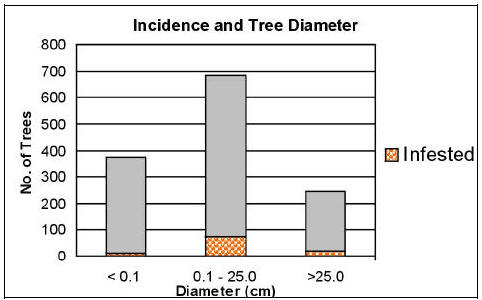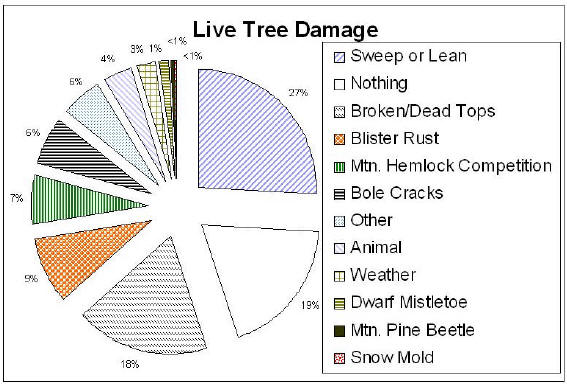Status of Whitebark Pine in Crater Lake National Park, Oregon, 2000
RESULTS and DISCUSSION
A total of twenty-four transects, consisting of 1200 trees, were inventoried. Blister rust was detected on all transects except three. The disease infects up to 20 percent of trees at some sites (Table 1). Disease was found on all size classes of pine. About 8 percent of trees greater than 25 cm dbh (diameter at breast height) were infected (Figure 2). Trees between 0.1 cm and 24 cm dbh exhibited infections at 12 percent. Nearly 3 percent of saplings (trees less than breast height) were infected. Infections are more difficult to detect on both saplings and very large trees, so incidence may be slightly higher.
Because currant shrubs are alternate hosts of the blister rust fungus, we hypothesized that transects with currants were more likely to have higher pine infection rates. Eleven transects had currants and proved to support significantly greater incidence (U=22; P<0.05, Mann-Whitney U-test). Transects without currants averaged 4 percent infection while currant-populated transects showed 12 percent infection, on average.
Although presence of currants appears related to diseased trees, this is not conclusive. Even though all four transects from the Mt. Scott – Cloudcap area were currant-free, the low incidence of rust may be more related to a cooler, drier weather pattern in this portion of the Park.
Blister rust poses a significant long-term threat to the Park’s whitebark pine population. Trees along the west caldera rim are dying the quickest. Annual loss is difficult to estimate without regular fixed-plot monitoring. Based on tallies of mature trees (D 7cm dbh) killed during the past year, we estimate the current rate on the western rim at 0.7 percent per year. Taking into account an optimistic estimate of recruited mature trees every year (0.3 percent) based on our inventory of size classes, we predict an overall decline of 0.4 percent for mature trees annually. Assuming that the disease has been in the Park since detected in the area during 1935 (USDA 1949), then at 0.4 percent annual mortality, current conditions may represent an overall shortfall of trees by 26 percent. That is, we would expect 26 percent more live and mature whitebark pine trees today.
 |
| Figure 2. Blister rust incidence and tree diameter within Crater Lake NP. |
This doesn’t appear alarming, however, this gradual decline will become more noticeable as time passes. At the current rate, within fifty years, there will be an additional 20 percent less whitebark pine on the western rim than today. This translates to whitebark pine obtaining nearly half of its historical abundance.
These estimates of whitebark pine decline should be considered conservative. Our ability to estimate long-term trends is limited because we don’t know how much rust mortality is associated with seedlings. This is difficult to diagnose and has strong implications on the number of survivors reaching mature stages. Furthermore, infection can be linked with regional climate changes, where under a general warming scenario we expect greater blister rust incidence, especially in the eastern portion of the Park.
Most whitebark pine trees showed signs of other damage (Figure 3). The most common maladies are leaning boles and sweeping tops. Damage signs which were detected are often interrelated and should not be considered independent. For instance, sweeping tops are generally weather related, but these trees were not noted as weather damaged because misidentifying the cause of common physical maladies is easy to do. Although 80 percent of trees showed signs of damage, in the vast majority of these, the injuries are not life threatening. Physical defects such as the loss of a tree’s top are endemic to whitebark pine. They have evolved in a harsh environment to be resilient to weather’s heavy forces.
 |
| Figure 3. Surveyed damage to whitebark pine within Crater Lake NP. |
The most lethal agents are generally blister rust, mountain pine beetle, and dwarf mistletoe (Arceuthobium sp.). Beetles and mistletoe are restricted to less than 2 percent of the Park’s trees – detected only on Wizard Island’s summit. Their damage is very visible to the visiting public who enjoy viewing Wizard Island from the caldera rim. We surveyed 100 trees (two transects), finding a species of mistletoe (probably A. americanum) to be the most important agent of damage on the island (Table 2). It appears that mistletoe activity on the island is not a recent phenomenon. Jackson and Faller (1973) observed many infested trees during the late-1960’s and recorded that 45 percent of trees greater than 10 cm dbh were dead. Why mistletoe and mountain pine beetle are restricted to Wizard Island is not known. The trees here may be under greater stress due to their open exposure to the elements. Soils are young and undeveloped, perhaps providing scant nutrients. Water availability is also very low at the summit.
| Table 2. Wizard Island’s biotic and potentially lethal agents of disturbance on whitebark pine (>0.1 cm dbh and mature krummholz). Seedlings are not included. |
 |
***previous*** — ***next***

